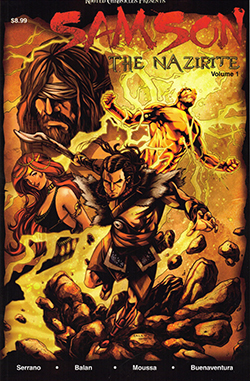
 SAN DIEGO – Rabbis sometimes invent short stories or elaborate on Jewish folktales to amplify the readings in Jewish Scriptures. Such a tale is known as a midrash.
SAN DIEGO – Rabbis sometimes invent short stories or elaborate on Jewish folktales to amplify the readings in Jewish Scriptures. Such a tale is known as a midrash.
With Comic-Con in town November 26-28 and my grandson Shor in attendance, I learned that comic book writers also engage in a bit of midrashim.
Shor picked up the first volume of a graphic novel titled Samson the Nazarite from one of the exhibitors at the special edition of Comic-Con at the San Diego Convention Center.
Published by a Christian-oriented organization called Rooted Chronicles, it followed the story of the Hebrew strong man fairly accurately, so far as I could tell from the Jewish Publication Society’s 1985 English translation of the Tanakh.
However, somewhere between Judges 13:1 and 14:20, a new story was inserted about a young man whom Samson rescued from a beating by three teenage boys. As in a modern Bruce Lee movie, Samson was able to defeat all three single-handedly. The boy whom he rescued was named in the comic book as Raphah. He grows into a very tall man.
In a later book of the Bible II Samuel 21, King David and his men slay four very tall sons of Raphah. So, the comic book version of Samson implies that these are descendants of the very same giant whom Samson rescued as a boy.
Raphah in the comic book version is instrumental in introducing Samson to his first Philistine wife, who never is named in the Bible, but who is named by comic book writer Luis Serrano as “Ninah.”
Samson didn’t have any money to pay the Philistine groomsmen at his wedding, so he made a bet with them that they couldn’t supply the answer to a riddle: “Out of the eater came something to eat; out of the strong came something sweet.” – a reference to a swarm of bees and honey he found in the skeleton of a lion he had killed with his bare hands a year before. The men didn’t know the answer to the riddle, so they conspired with Samson’s wife –“Ninah” of the comic book – to trick him into answering. In what was a harbinger of the famously devious relationship Samson later would suffer with Delilah, “Ninah” told him that if he really loved her, he would confide in her. Once he relented, she told the Philistines the answer to the riddle: “What is sweeter than honey, and what is stronger than a lion!”
Angered that the men had used his wife to learn his riddle—forcing him to bring back 30 tunics and 30 sets of clothing in payment of the bet – Samson went to the Philistine city of Ashkelon and killed 30 men, bringing back to his groomsmen the slain men’s tunics and clothing. Thereafter, Samson’s wife married one of the men who had been a wedding companion. According to the comic book, that man was Raphah.
Via email, I asked Serrano why he chose to insert the fictional Raphah into the Samson story.
He responded, “As we delved into the story, we read in Judges 14:20 and 15:2 that Samson’s wife was given to Samson’s ‘companion,’ sometimes translated as ‘friend.’ So, we wanted to introduce this as a minor character of someone Samson knew ahead of time. So, we created Raphah as that companion. Samson’s wife isn’t given a name in the text but like Raphah we wanted to give the character a name.”
And thus, another biblical legend was born.
*
Donald H. Harrison is editor of San Diego Jewish World. He may be contacted via donald.harrison@sdjewishworld.com